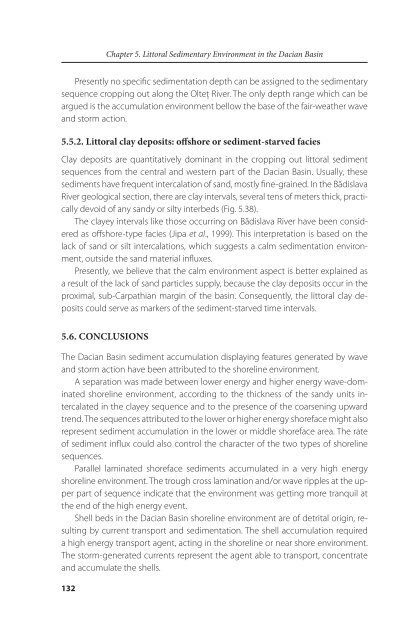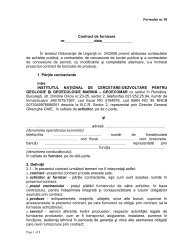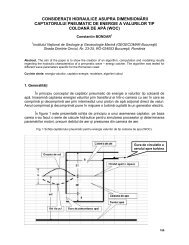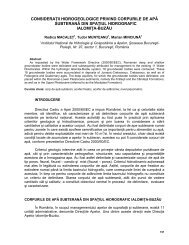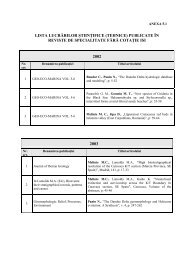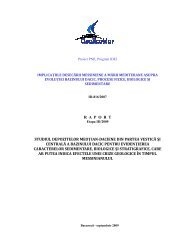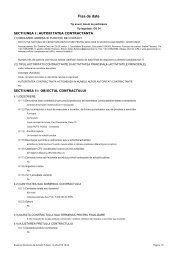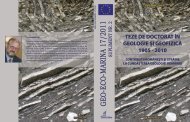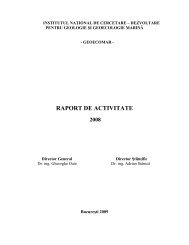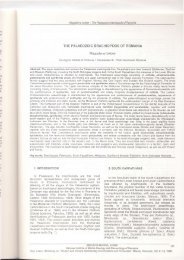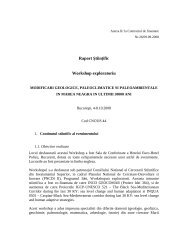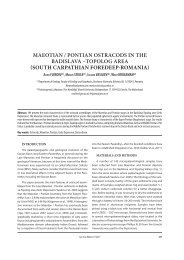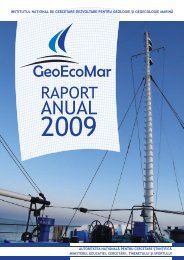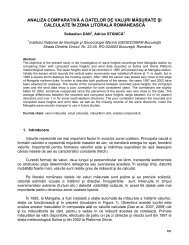DACIAN BASIN - GeoEcoMar
DACIAN BASIN - GeoEcoMar
DACIAN BASIN - GeoEcoMar
Create successful ePaper yourself
Turn your PDF publications into a flip-book with our unique Google optimized e-Paper software.
132<br />
Chapter 5. Littoral Sedimentary Environment in the Dacian Basin<br />
Presently no specific sedimentation depth can be assigned to the sedimentary<br />
sequence cropping out along the Olteţ River. The only depth range which can be<br />
argued is the accumulation environment bellow the base of the fair-weather wave<br />
and storm action.<br />
5.5.2. Littoral clay deposits: offshore or sediment-starved facies<br />
Clay deposits are quantitatively dominant in the cropping out littoral sediment<br />
sequences from the central and western part of the Dacian Basin. Usually, these<br />
sediments have frequent intercalation of sand, mostly fine-grained. In the Bădislava<br />
River geological section, there are clay intervals, several tens of meters thick, practically<br />
devoid of any sandy or silty interbeds (Fig. 5.38).<br />
The clayey intervals like those occurring on Bădislava River have been considered<br />
as offshore-type facies (Jipa et al., 1999). This interpretation is based on the<br />
lack of sand or silt intercalations, which suggests a calm sedimentation environment,<br />
outside the sand material influxes.<br />
Presently, we believe that the calm environment aspect is better explained as<br />
a result of the lack of sand particles supply, because the clay deposits occur in the<br />
proximal, sub-Carpathian margin of the basin. Consequently, the littoral clay deposits<br />
could serve as markers of the sediment-starved time intervals.<br />
5.6. CONCLUSIONS<br />
The Dacian Basin sediment accumulation displaying features generated by wave<br />
and storm action have been attributed to the shoreline environment.<br />
A separation was made between lower energy and higher energy wave-dominated<br />
shoreline environment, according to the thickness of the sandy units intercalated<br />
in the clayey sequence and to the presence of the coarsening upward<br />
trend. The sequences attributed to the lower or higher energy shoreface might also<br />
represent sediment accumulation in the lower or middle shoreface area. The rate<br />
of sediment influx could also control the character of the two types of shoreline<br />
sequences.<br />
Parallel laminated shoreface sediments accumulated in a very high energy<br />
shoreline environment. The trough cross lamination and/or wave ripples at the upper<br />
part of sequence indicate that the environment was getting more tranquil at<br />
the end of the high energy event.<br />
Shell beds in the Dacian Basin shoreline environment are of detrital origin, resulting<br />
by current transport and sedimentation. The shell accumulation required<br />
a high energy transport agent, acting in the shoreline or near shore environment.<br />
The storm-generated currents represent the agent able to transport, concentrate<br />
and accumulate the shells.


